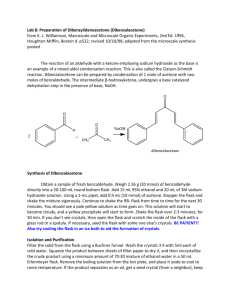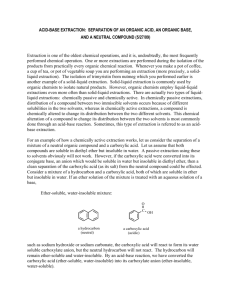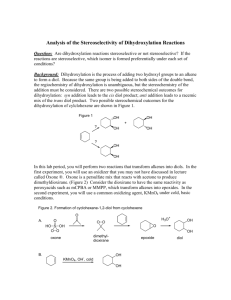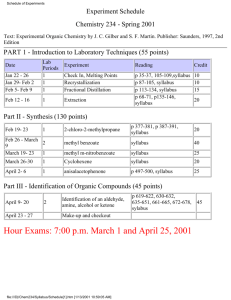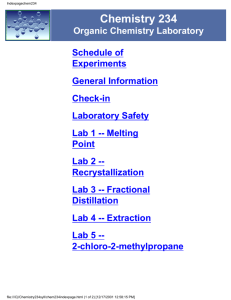Oxidation of a side chain & introduction to IR and nmr
advertisement
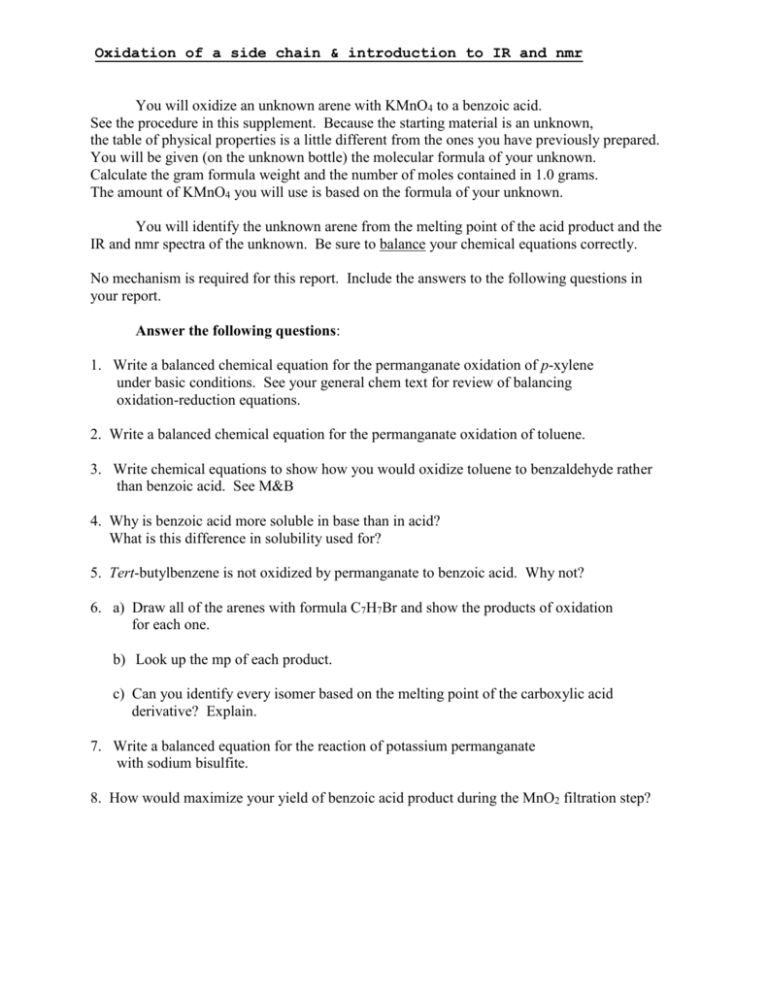
Oxidation of a side chain & introduction to IR and nmr You will oxidize an unknown arene with KMnO4 to a benzoic acid. See the procedure in this supplement. Because the starting material is an unknown, the table of physical properties is a little different from the ones you have previously prepared. You will be given (on the unknown bottle) the molecular formula of your unknown. Calculate the gram formula weight and the number of moles contained in 1.0 grams. The amount of KMnO4 you will use is based on the formula of your unknown. You will identify the unknown arene from the melting point of the acid product and the IR and nmr spectra of the unknown. Be sure to balance your chemical equations correctly. No mechanism is required for this report. Include the answers to the following questions in your report. Answer the following questions: 1. Write a balanced chemical equation for the permanganate oxidation of p-xylene under basic conditions. See your general chem text for review of balancing oxidation-reduction equations. 2. Write a balanced chemical equation for the permanganate oxidation of toluene. 3. Write chemical equations to show how you would oxidize toluene to benzaldehyde rather than benzoic acid. See M&B 4. Why is benzoic acid more soluble in base than in acid? What is this difference in solubility used for? 5. Tert-butylbenzene is not oxidized by permanganate to benzoic acid. Why not? 6. a) Draw all of the arenes with formula C7H7Br and show the products of oxidation for each one. b) Look up the mp of each product. c) Can you identify every isomer based on the melting point of the carboxylic acid derivative? Explain. 7. Write a balanced equation for the reaction of potassium permanganate with sodium bisulfite. 8. How would maximize your yield of benzoic acid product during the MnO2 filtration step? Identification of an unknown arene by oxidation to the carboxylic acid; introduction to IR and nmr spectroscopy. A classical approach to the identification of some aromatic compounds is the oxidation of side chains to carboxylic acid groups. Measurement of the derivative's melting point and comparison with the known melting points of different benzoic acids provided a means of identifying or eliminating certain possible structures. For example: if a compound was found to have the formula C8H10, it could be four different compounds: ethyl benzene, o-xylene, m-xylene, or p-xylene. If you look up the boiling points of these four compounds, they are very close to each other. On the other hand, the melting points of the corresponding carboxylic acids produced from the oxidation of the side chains are distinctly different. When combined with additional information, such as the IR and nmr spectra, the melting point of the derivative will usually be sufficient to determine the structure of the unknown. You will be given a small sample of an unknown arene for which the only information provided is the molecular formula. You are to carry out the permanganate oxidation in alkalai solution and isolate the carboxylic acid. You will measure the melting point of the acid and compare it to the melting points of the possible derivatives from your molecular formula. In addition, you will obtain the IR spectrum of your original uknown and the nmr spectrum. Procedure: Charging the flask 1. The apparatus consists of a 250 mL round-bottom flask fitted with a reflux condenser. 2. Using your cork ring, place about 1 gram (40 drops) of the unknown into the flask. Weigh accurately to two decimal places. 3. Add approx. 80 mL of water and 1-2 mL ( 1 pipet full ) of 6M NaOH to the flask. 4. Using the powder funnel, introduce the required amount of potassium permanganate (see table below) into the flask. Stopper the flask with a greased pennyhead stopper, put the flask into a 600 mL beaker, and put it into your cabinet. compound formula C7H8 C8H10 C9H12 g KMnO4/g unknown 4g 6g 8g The Reaction 5. Add a magnetic stirring bar to your flask, attach a reflux condenser and begin heating the mixture on a hot plate ( see prep notes ). Be careful when the mixture first starts to boil as it has a tendency to "bump". Continue the reflux for 2-3 hours. At the end of the period, cool the flask, label it, cork it ( prep notes ), and place it in your cabinet. Isolation and Recrystallization 6. Suction filter the contents of the round-bottom flask to remove the solid MnO2. 7. Transfer the filtrate to a 250 mL beaker. (If the solution is still purple due to excess permanganate, destroy it by adding small amounts of solid sodium bisulfite, until the solution turns clear. Place the beaker in a ice bath, and after the solution has cooled for 10 minutes, acidify with 10 mL of 6 M H2SO4, while stirring. 8. Test the solution with litmus to verify that it is acidic; if not add more sulfuric acid. 9. Filter the precipitated acid with suction through a small buchner funnel and wash with a few mL of cold water. (If no acid has precipitated, consult with the instructor). 10. Recrystallize the acid from a suitable solvent (try water first). 11. Let the product air dry, weigh it, package it, and obtain its melting point.



